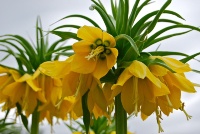Login to edit
An inheritance group references a group of content elements. It extends the functionality of the element group by passing on the content element configuration down the navigation tree.
OpenCms 8.5 Demo Content
Search for content
Page subscription
Most Recent News
Exciting new Acacia variety discovered
Sep 24, 2012
An element group (like this one) allows you to group multiple content elements together and share them on several pages.
Crown imperial

The Crown imperial or Kaiser's Crown (Fritillaria imperialis) is a member of the genus Fritillaria, family Liliaceae.
It is native to a wide stretch from Anatolia across the plateau of Iran to Afghanistan, Pakistan and the Himalayan foothills. It is one of the earliest plants to be cultivated. It grows to about 1 meter (3 feet) in height, and bears lance shaped, glossy leaves, at intervals along the stem. It bears a prominent whorl of downward facing flowers at the top of the stem., topped by a 'crown' of small leaves, hence the name. While the wild form is usually orange-red, various colours are found in cultivation, ranging from nearly a true scarlet through oranges to yellow. The pendulous flowers make a bold statement in the late spring garden ; in the northern hemisphere, flowering takes place in late April or May, accompanied by a distinctly foxy odour that repels mice, moles, and other rodents.
Due to the way that the bulb is formed, with the stem emerging from a depression, it is best to plant it on its side, to prevent water causing rot at the top of the bulb. Fritillaria imperialis requires full sun for best growth, and sandy, well-drained soil for permanence. After flowering and complete drying of the leaves, the stems should be cut off just above the ground.
This article uses material from the Wikipedia article Fritillaria imperialis and is licensed under the GNU Free Documentation License.


